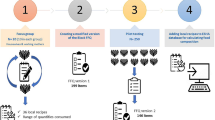Abstract
The accurate assessment of dietary intake patterns is important for the determination of total dietary arsenic (As) exposure in As-contaminated regions of Bangladesh. Food intake questionnaires are a common means of assessing food intake. A food frequency questionnaire (FFQ) was designed to assess the daily intake of frequently consumed food items and was successfully implemented to assess dietary patterns and intake of the rural populations in 18 villages from three Districts of Bangladesh (Comilla, Manikganj Sadar, and Munshiganj). The FFQ presented in this paper comprises a complete set of tools which allowed not only collection of information on dietary patterns but also information on the spatial characteristics of the landscape, socio-demographic indicators, and geographic locations of the identified environmental media of the contaminants, which resulted in As exposure to humans. The FFQ was designed in three sections: (1) general household information, (2) household water and rice information, and (3) individual dietary intake of other foods. The dietary intake of other food was then further subdivided into five different food subgroups: (i) grain intake, (ii) protein intake, (iii) fruit intake (iv), vegetable intake, and (v) dal (pulse) intake. During the design and development of the FFQ, emphasis was given to the source of food, the frequency (day/week/month) of consumption, and the daily amount of food consumed by each adult male, adult female, and child to accurately determine the dietary pattern and intake of arsenic in the rural population of Bangladesh.

Similar content being viewed by others
References
Alam, M. G. M., Snow, E. T., & Tanaka, A. (2003). Arsenic and heavy metal contamination of vegetables grown in Samta village, Bangladesh. Science of the Total Environment, 308, 83–96.
Al Rmalli, S. W., Haris, P. I., Harrington, C. F., & Ayub, M. (2005). A survey of arsenic in foodstuffs on sale in the United Kingdom and imported from Bangladesh. Science of the Total Environment, 337(1–3), 23–30.
Bae, M., Wantanabe, C., Inaoka, T., Sekiyama, M., Sudo, N., Bokul, M. H., et al. (2002). Arsenic in cooked rice in Bangladesh. The LANCET, 360(9348), 1839–1840.
BGS. (1999). Groundwater studies for arsenic contamination in Bangladesh (Final Report). British Geological Survey and Mott MacDonald Ltd (UK).
Chen, Y., Ahsan, H., Parvez, F., & Howe, G. R. (2004). Validity of a food-frequency questionnaire for a large prospective cohort study in Bangladesh. British Journal of Nutrition, 92, 851–859.
Chowdhury, U. K., Rahman, M. M., Mondal, B. K., Paul, K., Lodh, D., Biswas, B. K., et al. (2001). Groundwater arsenic contamination and human suffering in West Bengal, India and Bangladesh. Environmental Sciences, 8(5), 393–415.
Duxbury, J. M., Mayer, A. B., Lauren, J. G., & Hassan, N. (2003). Food chain aspects of arsenic contamination in Bangladesh: Effects on quality and productivity of rice. Journal of Environmental Science and Health, A38(1), 61–69.
Huq, S. I., Correll, R., & Naidu, R. (2006). Arsenic accumulation in food sources in Bangladesh. In R. Naidu, E. Smith, G. Owens, P. Bhattacharya, & P. Nadebaum (Eds.), Managing arsenic in the environment: From soil to human health (pp. 283–293). Australia: CSIRO Publishing.
Khan, N. I., Bruce, D., Naidu, R., & Owens, G. (2009). Implementation of food frequency questionnaire for the assessment of total dietary arsenic intake in Bangladesh: Part-B—Preliminary findings. Environmental Geochemistry and Health. doi:10.1007/s10653-008-9232-3.
Meharg, A. A., & Rahman, M. M. (2003). Arsenic contamination of Bangladesh paddy field soils: Implications for rice contribution to arsenic consumption. Environmental Science Technology, 37(2), 229–234.
Miller, R., Correll, R., Dillon, P., & Kookana, R. (2002). ASRRI: A predictive index of contaminant attenuation during aquifer storage and recovery. In P. Dillon (Ed.), Management of aquifer recharge for sustainability (pp. 69–76). Balkema Publishers: Australia.
Naidu, R., Huq, I., Smith, E., Correll, R., Smith, L., Smith, J., et al. (2002). Assessing potential arsenic exposure pathways in Bangladesh. Paper presented at the 5th International Conference on Arsenic Exposure and Health Effects, San Diego, California, USA.
Owens G., Rahman M. M., Heinrich T. & Naidu R. (2004). Bangladesh-Australia Centre for Arsenic Mitigation Program (BACAMP): Program 3: Safe food, Section 1: Arsenic food chain assessment, University of South Australia, Consultancy report for GHD Pty Ltd.
Roychowdhury, T., Uchino, T., Tokunaga, H., & Ando, M. (2002). Survey of arsenic in food composites from as arsenic-affected area of West Bengal, India. Food Chemical Toxicology, 40, 1611–1621.
Acknowledgements
The authors extend their thanks to DCH for their support and assistance during field surveys and for supplying laboratory facilities for sample pre-processing. The authors also gratefully acknowledge the financial support provided for this project by AusAID. The Centre for Environmental Risk Assessment and Remediation (CERAR), and the University of South Australia provided financial support and the University of Dhaka provided study leave for Nasreen Islam Khan while she pursued her PhD studies.
Author information
Authors and Affiliations
Corresponding author
Appendix: A
Appendix: A









Rights and permissions
About this article
Cite this article
Khan, N.I., Owens, G., Bruce, D. et al. An effective dietary survey framework for the assessment of total dietary arsenic intake in Bangladesh: Part-A—FFQ design. Environ Geochem Health 31 (Suppl 1), 207–220 (2009). https://doi.org/10.1007/s10653-008-9234-1
Received:
Revised:
Accepted:
Published:
Issue Date:
DOI: https://doi.org/10.1007/s10653-008-9234-1




